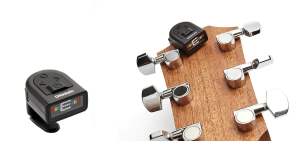How to Tune a Ukulele

Standard Ukulele Tuning
Most soprano, concert, and tenor ukuleles are tuned to standard tuning.
Standard Tuning: G, C, E, A

As you can see in the picture, the first ukulele string (the string at the bottom when holding the instrument in playing position) is tuned to A (la). The second string is E (mi), the third string is C (do), and the fourth string is G (sol) (the top string when holding the instrument in playing position).
Tuning with a Chromatic Tuner
The simplest way to tune a ukulele is by using a chromatic tuner. A chromatic tuner is a device that shows the pitch of a string when it is plucked. With the help of the tuner, you can quickly determine whether the note is below or above your desired pitch.
One of the most convenient tuners for ukuleles is the D’Addario PW-CT-12 chromatic tuner. It is small and portable, and it doesn’t get in the way when putting the instrument in or taking it out of its case, so you can leave it on the instrument without worrying about losing it.
You can also use apps for tuning your ukulele, which you can download to your smartphone. When using a phone for tuning, it's best to do so in a quiet environment, as the ukulele is tuned using the microphone. Background noise can interfere with the tuning process.

Other Common Ukulele Tunings
Low G Tuning – This tuning involves tuning the G string an octave lower than usual. If you want to use this tuning, you'll need special strings designed for low G tuning. Standard strings are not suitable for this tuning. Using low G tuning makes the ukulele sound fuller and have better resonance.
Baritone Tuning – Baritone tuning is used when playing a baritone ukulele. This tuning is exactly the same as tuning the four highest strings of a guitar.




